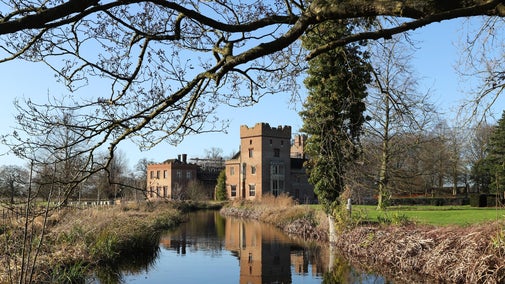
Donate
Everyone needs nature, now more than ever. Donate today and you could help people and nature to thrive at the places we care for.

Whatever the time of year, there's plenty of work to be done in the garden and on the estate at Bateman's. No two days are the same for our team. The team aim to capture the spirit of the outdoors as it would have been when Rudyard Kipling lived here.
The Kipling family had a major influence on the layout of the garden at Bateman’s – which is still in existence today – planting yew hedges to create privacy and divide the space into garden rooms. Many of the character features are Kipling additions, such as the orchard, Pear Alley, lily pond and rose garden.
At Bateman’s our garden team is working hard to maintain these existing features as close to Kipling’s design as possible, including replacing plants with the original species where they’re still available. For example, we’ve refurbished the spring and front garden borders and they now look more like they did during Kipling’s time.
Our garden team have recently restored Pear Alley. Located at the bottom of the orchard this is a metal hooped structure, 20 metres in length spanning a paved pathway originally created by Rudyard Kipling circa 1905.
The tunnel effect provided Kipling with a long vista from the orchard towards the house at Bateman's. Sitting on an old oak bench seat at the far end of the alley, he could rest and admire the home he'd bought and ponder both the responsibilities and humour of becoming 'one of the landed gentry'.
As the name suggests, the structure was planted with espaliered pear trees, trained to grow over the metalwork, adorned with white pear blossom in April and golden dropping pears in autumn. In more recent years, narrow borders were created, with low perennial groundcover plants growing underneath the pear trees.

In 2000 the original pear trees were removed because they had become entangled with the framework. The ironwork was repaired, and replacement trees planted. Recently these plants, grown on a poor rootstock, have declined, and succumbed to various fruit tree diseases.
In February 2024, our garden team planted 22 new pear trees, provided by the National Fruit Collection at Brogdale, and grown on a semi-vigorous rootstock, which should mean the trees grow strong and tall enough to once again cover the metal structure. The new underplanting was designed to better reflect the romantic, floristic Art’s & Craft’s style which influenced the design of Kipling’s garden, with an extended period of interest achieved through the careful selection of plants providing flower and leaf interest from March to November.
Len Bernamont, Gardens and Outdoors Manager at Bateman’s says: “Pear Alley is one the most significant surviving features of Rudyard Kipling's garden. The Queen's Green Canopy fund and a donation from the Eastbourne NT Association have provided us with an opportunity to restore this feature closer to the way it originally would have looked, and at the same time, introduce more blossom and variation in flower forms to provide forage for pollinators in the garden.”

Gardens continually evolve, and our gardening team is always investigating new planting ideas, particularly in the Mulberry Garden which, although referred to as Kipling’s kitchen garden, was formal in design; the planting was largely a mixture of herbaceous perennials and shrubs with the clever use of fruit trees adding both structure and productive qualities to what was a very ornamental design. We currently use annual flowers and vegetables to reflect the same ornamental and productive qualities of Kipling’s earlier design.

– Len Bernamont, Garden and Outdoors Manager at Bateman’s
One big challenge our gardeners face is contending with historic winter flooding of the lower parts of the garden from the River Dudwell, which flows through the Wild Garden.
At Bateman's, we are currently working with other organisations including the High Weald Natural Landscape, Southeast Rivers Trust and Environment Agency to explore options for natural flood management. Methods being considered include leaky dams which allow the river to flow freely at normal levels but during a flood, when the water tops its banks, they force it out into fields that have the capacity to hold it and grass bunds.
Tree and hedge planting will capture and slow more of the water running off the slopes, with depressions created in some of the fields, to hold even more water for longer. Not only will these actions mitigate the flooding, they will create new habitats for a variety of species, including wading birds.
Being open for 363 days of the year means we do all the garden maintenance, such as lawn repair, in public view. We carry out as much noisy machinery work as we can out of hours but working in view of visitors does enable lots of opportunities to engage with people hopefully allowing a much deeper insight into our conservation work.
In comparison to the abundant, colourful borders and flowerbeds of summer, the winter garden at Bateman's can be less vibrant. However, our garden team can't afford to sit back and relax as there are a surprising number of jobs that need to be done during this quiet time.
One substantial task that needs doing in winter is to clip the many yew hedges around the garden, as well as the rows of pleached limes on the lawn. This is carried out meticulously by our team of gardeners and opens up the views from the garden out across the estate.

The festive season is a busy time at Bateman's, full of activity as we welcome visitors to enjoy our special themed Christmas events, activites and decorations.
- Len Bernamont, Garden and Outdoors Manager
There are many jobs to do at this time of year, especially as the days get shorter. But while putting the garden to bed, the gardeners at Bateman’s are already thinking ahead to their spring jobs. They know it won’t be long until they see the first green leaves and developing flower heads of the snowdrops in January that herald the vibrant spring colour to come.
Bateman's estate covers over 300 acres and has a wealth of different habitats for wildlife – hay meadows, coppiced woodland, ponds, streams and a river. Our team carries out conservation activities throughout the year to maintain these habitats and protect the wildlife living in them, including coppicing in the winter and restoring the hay meadows in the summer.
On the estate, there are 19 ponds (remnants of the Wealden iron industry) that became overgrown. Our team has worked hard to revitalise some of these to create a habitat to attract rare amphibians, as well as dragonflies and damselflies, with ponds at different stages of succession.
In 2016, we successfully applied for grant funding for work on three of the ponds on the Bateman's estate. Contractors de-silted the ponds, and some of the trees were cleared from around them to allow more light and warmth onto the water. This should increase the number of species and help amphibian eggs to develop successfully.

One of the ponds previously dried out every summer preventing the successful development of young great crested newts. We installed a liner and, in 2019, we discovered that adult great crested newts had taken up residence for the first time. Two of the ponds are adjacent to public rights of way so can be visited easily.
– Kevan Gibbons, Ranger
As part of the National Trust’s work to help reverse the UK’s decline in wildlife, we have been monitoring the number of newts and other wildlife in the ponds since the project to revitalise them. During recent surveys, we’ve been thrilled to find dragonflies and damselflies in all the restored ponds. Encouragingly, great crested newt numbers are increasing too.
These are species we’ve never recorded in these locations before, so we can safely say the work we carried out has improved biodiversity of the network of ponds on the estate. We are gradually working on more of the ponds.

Coppicing is one of the ways we look after the woodland here at Bateman’s, using the ancient technique to create or restore habitats that will support a wide diversity of species, both plants and animals. It traditionally takes place from November to the end of March so that we can reduce the impact on the nature already living in our woodland such as nesting birds and ground plants.
As you’re walking through the countryside at Bateman’s on one of the waymarked estate walks, you may come across small areas where we are coppicing.
This practice can be traced back to Neolithic times and refers to deliberate felling of trees, with sprouts then growing from the cut stump (stool). It provides a sustainable supply of wood for a variety of uses. This continuous cycle of thinning and clearance followed by regrowth allows a mosaic of different habitats to form, encouraging new plant growth and insect activity.
- Kevan Gibbons, Ranger
We stack material from coppicing to create habitats for nesting birds and over-wintering newts and frogs. These piles also provide places for fungi to grow and insects to lay their eggs. Plants too – such as honeysuckle, bramble and travellers joy – will colonise these habitat piles, attracting invertebrates: butterflies, moths, bees, wasps and hoverflies.
Some of the coppiced wood is used in the garden for pea-sticks and other plant supports, or to protect new growth from nibbling by deer.
With your ongoing support, we're able to continue our vital conservation work. Thank you for helping to protect these special places.

Everyone needs nature, now more than ever. Donate today and you could help people and nature to thrive at the places we care for.
Discover the garden at Bateman's. Find out what to see, from the Rose Garden designed by Kipling to wildflowers, an orchard and even a working mill.

Explore the estate at Bateman's. Discover what to see and do, from wildlife to seasonal plants and walks, in a landscape that inspired Kipling.

Discover where to eat and shop at Bateman’s, the home of author Rudyard Kipling. Stop for a hot drink or light meal, and then browse for the perfect gift or pre-loved book.

Discover the history of Bateman's. Explore its 17th-century beginnings and why the house and garden were so special to Rudyard Kipling and his family.

We believe that nature, beauty and history are for everyone. That’s why we’re supporting wildlife, protecting historic sites and more. Find out about our work.

Read about our strategy, which focuses on restoring nature, ending unequal access and inspiring more people.
